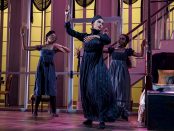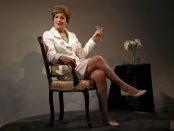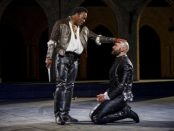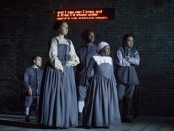Joan Marcus
Joan Marcus is one of the preeminent theatrical photographers working in the US today. Over the past 25 years she has photographed over 500 shows on and off Broadway and regionally. A native of Pittsburgh, Pennsylvania, Joan graduated from George Washington University. In 2014 she received a Tony Honor for Excellence in the Theater. Joan Marcus is married to the theatrical press agent Adrian Bryan-Brown of Boneau/Bryan-Brown, a leading Broadway press agency. http://www.joanmarcusphotography.com/
"Bernhardt/Hamlet" is structured as a backstage comedy. Sarah rehearses with French stage star Constant Coquelin playing both The Ghost and Polonius, worries that she is losing 29-year-old lover, playwright Rostand to his wife – or to his new play "Cyrano de Bergerac," and frets over her son Maurice, at 29 years old still a college student who in need of money. Added to her troubles her illustrator Alphonse Mucha whose posters of her productions have added to her fame and glory is unable to make a sketch of her as Hamlet which suits them both. Worse still all the men in her life – including the Parisian critical establishment – plus the women of Paris are saying that it is not appropriate for her to play Hamlet in breeches as it is a man’s domain. Although the new play is not entirely about women in a man’s world, Rebeck does give this theme major importance. Ultimately, Sarah receives a visit from Rostand’s clever wife Rosamund which leads to the play’s denouement. [more]
A Lovely Sunday for Creve Coeur
What gives "A Lovely Sunday for Creve Coeur" its special cachet in the Williams canon is that its storyline and heroine called Dorothea very much suggest a prequel to A Streetcar Named Desire set ten years earlier, when Blanche was still teaching and coping with life, though already needing liquor and pills to get her over her anxieties. Some enterprising theater group ought to schedule these two plays in repertory with the same actress in the leading role in each. [more]
I Was Most Alive with You
In Craig Lucas’s "I Was Most Alive with You," two down-on-their-luck television writers mine recent personal tragedy for their latest project, hoping, with the Book of Job as their inspirational guide, to set both their careers and the universe in order. Although suffering has touched each of them, Ash (Michael Gaston), a late middle-aged recovering alcoholic in a bad marriage, is the much more forlorn figure. Like Job, Ash has hit one of those rough patches in life, where, if you’re a person of faith, you might start to suspect that your higher power doesn’t like you very much. [more]
Collective Rage: A Play in 5 Betties
The actual subtitle of Silverman’s play gives one pause: “In Essence, A Queer and Occasionally Hazardous Exploration; Do You Remember When You Were in Middle School and You Read About Shackleton and How He Explored the Antarctic?; Imagine the Antarctic as Pussy and It’s Sort of Like That.” While this might suggest that the play is overwritten and self-indulgent, it belies the concise, tight writing and structure of Silverman’s comic/angry play which is always surprising, always inventive, always inducing laughter. The play does use Brechtian supertitles to announce the scenes but these are comic and informative, rather than didactic or preachy. [more]
The Gospel at Colonus
The complexities of this Greek tragedy are shoe-horned into a Gospel service with songs ranging from the thoughtful (“The Invocation”) to the formal (“Creon Comes to Colonus”) to the awe-inspiring (“The Descent of Oedipus”) and finally to the heartbreaking (“The Sermon” and “Closing Hymn”), all variations on the well-known Gospel/Blues/Christian Hymn musical repertory. [more]
Smokey’s Joe’s Café: The Songs of Leiber & Stoller
Although "Smokey Joe’s Café" has been seen in New York before, the new production now at Stage 42 is an entirely different incarnation of the show that still holds the record for Broadway musical revues having racked up 2,036 performances. The new version which again uses nine talented and dynamic singers and dancers, five men and four women, has deleted five songs and added five, rearranged the song list for a new total of 40, and eliminated the intermission. It is now a more streamlined version of the 1995 show. [more]
Gettin’ the Band Back Together
If the show plays like it was written by a committee, in fact, it has been. The book is by producer/ writer Ken Davenport and The Grundleshotz who turn out to be a group of performers and writers who originally workshopped the show in a series of improvised rehearsals. For the record, they are Sebastian Arcelus, Fred Berman, Michael Hirstreet, Jenna Coker Jones, Craig Jorczak, Nathan Kaufman, Emily McNamara, Jennifer Miller, Bhavesh Patel, Sarah Saltzberg (who is credited with additional material), Michael Tester, as well as Jay Kaitz who plays the second male lead in the show, Bart Vickers as though he were auditioning for Dewey, the laid-back music teacher in "School of Rock." [more]
The New One
Comedian/monologist Mike Birbiglia, best known for "Sleepwalk with Me," has the remarkable knack of finding humor in autobiographical crises that shouldn’t be funny but in his hands are uproarious. His latest show, "The New One," is just as hilarious as the previous ones. When Mike and his wife, the poet Jennifer Hope Stein, got married he pointedly told her that he did not ever want to have children, and she agreed. Ten years later Jen has changed her mind and tells him, “A baby wouldn’t have to change the way we live our lives,” probably the understatement of the century. [more]
Twelfth Night 2018 (Free Shakespeare in the Park & Public Works)
Shaina Taub’s joyful and sunny updated musical version of Shakespeare’s comedy, "Twelfth Night," is back in a full production courtesy of Free Shakespeare in the Park and Public Works which premiered an earlier production for four performances during Labor Day Weekend 2016. This slightly trimmed and tightened version is even more entertaining and the witty contemporary lyrics make this fun for young and old, as well as Shakespeare veterans and novices. [more]
Straight White Men
Given how physically playful the brothers are with each other--and with their father--"Straight White Men" is that rare play that even has a credited choreographer, Faye Driscoll. In addition to making good on the promise he made in last year’s "Call Me By Your Name," that he was an actor to be watched--and not only because he’s so attractive--Armie Hammer proves especially deft with Driscoll’s many maneuvers, like leaping on or off the sofa or the coffee table. [more]
Head Over Heels
Under Michael Mayer’s fast-paced direction, "Head Over Heels" starts badly and busily but eventually slows down to a delightful Elizabethan parody on love and gender. While not all of The Go-Go’s songs are suitable for the storyline and the period, enough of them fit perfectly to make this a superior light entertainment. The cast is first rate and may make stars of the ingenious Andrew Durand and the classy and stylish Peppermint. Aside from introducing The Go-Go’s song catalog to Broadway, "Head Over Heels" covers a great many firsts of all kinds. [more]
The House That Will Not Stand
Gardley makes use of a little known piece of American history: while Louisiana was under Spanish and later French rule, it had a three-tiered racial system. Aside from white settlers and black slaves, there was a third class: free women of color (mostly Creoles) could enter into a relationship with white men as common-law wives. Their children could inherit part of their estates. Some of these so-called “colored” women became extremely rich. This system was called plaçage and such women were known as placeés. The lighter the woman’s skin color the higher her social caste. However, when Louisiana was sold to the new United States in 1803, this system was frowned upon and eventually went out of style around 1813 due to legal challenges. [more]
Don’t Bother Me, I Can’t Cope
This plotless, mostly sung-through exhibition conveys the tumultuous 20th century urban African-American experience through Micki Grant’s dazzling score for which she wrote both the music and lyrics. “Universe in Mourning,” “Harlem Streets,” “Ghetto Life” and “Billie Holiday Blues” are some of the titles. [more]
Fire in Dreamland
Built in 1904, Dreamland was considered the most elegant and ambitious of Coney Island’s amusement parks--until it burnt to a crisp in 1911. A new play by Rinne Groff, "Fire in Dreamland" is ostensibly about the disaster, in which no humans but most of the animals perished. But to add that it’s set a little more than a century later--in 2013, or some months after Super Storm Sandy wreaked havoc on the east coast--should begin to suggest that there’s more going on here than, unfortunately, ever meets the eye. [more]
The Originalist
n what easily could have become a one-man show, playwright Strand has cleverly created dramatic tension by first introducing us to a second character and later a third. Set during the 2012-2013 term of the Supreme Court, the play begins with a lecture by Scalia to a law class where he explains his philosophy of being an “originalist,” that is, someone who interprets the Constitution as it was originally written and understood by its drafters in 1789. This presupposes that it is not a living document that should reflect each era, but something carved in stone which does not change but may need interpretation. [more]
Mary Page Marlowe
After establishing himself as one of our finest playwrights with such works as "Killer Joe" and "August: Osage County," Tracy Letts seems to have somewhat lost his way with his more recent "Mary Page Marlowe." Now playing at the Second Stage Theater in New York, "Mary Page Marlowe" premiered at Chicago’s Steppenwolf Theater two years ago. With six different actresses representing the title character at many different times in her life, it essentially relates a single, long life span, in only 90 long minutes. [more]
Songs for a New World
The unison of Jason Robert Brown’s accomplished score, Kate Whoriskey’s exciting direction and Rennie Harris’s vibrant choreography make this New York City Center Encores! Off-Center’s revival of his 1995 debut show "Songs for a New World," a dynamic theatrical experience. Mr. Brown’s surprise appearance at the piano to play a song in the second act was electrifying. [more]
Carmen Jones
Unlike the musicals "Rent" (an update on Puccini’s "La Boheme"), and "Miss Saigon' (inspired by Puccini’s "Madame Butterfly") both of which had all new music by other composers for their contemporary stories, "Carmen Jones" uses the original Bizet score. However, it is not simply an English translation. Hammerstein has written all new lyrics to place the story in a W.W. II Southern community (possibly North Carolina) and with the characters ending up in Chicago for the denouement. While "Carmen Jones" was a smash hit originally running for 503 performances at the Broadway Theatre during the war years, some like then critic James Baldwin found the dialect that Hammerstein had used for his African-American characters both embarrassing and demeaning, and the show has not had a New York revival until now. Notwithstanding, the first London production in 1991-92 was also a tremendous success at the Old Vic Theatre with a mix of both opera and theater stars in the cast. [more]
Skintight
Harmon’s new play resembles "Admissions," his last New York offering seen at Lincoln Center this March, in that it debates a topic from many sides but then fails to give us the author’s point of view on it at the end. Like all of his four plays so far it offers a strong character who has a very big gripe with the way things are and who attempts to change people accordingly. And like the others, "Skintight" is very funny while it deals with a serious topic but ultimately seems rather superficial, though here that maybe because of the extremely wealthy milieu in which money is no object and things magically appear via live-in servants. As is Harmon’s wont, the acerbic repartee is tossed about plentifully and as directed by Daniel Aukin, the six actors get the most out of their snappy lines. [more]
Laura Bush Killed a Guy
With her honeyed and smoky Texan vocal inflections, wearing a short-haired lustrous brown wig and costume designer Rhonda Key’s gleaming trim white suit, actress Lisa Hodsoll is phenomenal as former First Lady Laura Bush in author Ian Allen’s kaleidoscopic solo play, "Laura Bush Killed a Guy." For 95 mesmerizing minutes, Ms. Hodsoll gives a smashing performance that transcends mere impersonation or campy replication. Looking and sounding like Mrs. Bush, with her twinkling eyes and beaming presence, Hodsoll’s characterization is a dazzling amalgam of comedy, emotion and depth. An only child, she and her parents went on a mission... [more]
Log Cabin
Harrison’s dialogue is well-crafted and often in setup punchline mode peppered with plentiful pop culture references that falls flat. The overall effect is of a rote accumulation of touchstones appealing to this strata. It’s all without resonance unless one is like the characters being depicted. It’s certainly possible to dramatize the concerns of differing classes with cross-sectional interest but that is not the case in "Log Cabin." This title is most likely a play on Log Cabin Republicans who are gay and might reflect that some of the characters are actually more Conservative then they let on. [more]
Othello (Shakespeare in the Park)
In the recent Metropolitan Opera production of Verdi’s "Otello," Otello was white which left no reason for his jealousy if he was identical to all the Venetians around him. In the current Shakespeare in the Park production, using color blind casting, Santiago-Hudson chooses to make at least five of the leading characters people of color so that Othello is no longer an outsider, nor are they. The meaning of the theme is diluted in such a reading. It may be politically correct, but in this play about race there is no getting away from its original meaning. Even The Public Theater’s artistic director Oskar Eustis’ program notes remark that Othello is only one of two explicitly black characters in all of Shakespeare, the other appearing in "Titus Andronicus." Other than this casting choice, the production offers no new interpretation of the play or characters, making it more like a staged reading than a full production. [more]
Dan Cody’s Yacht
Both Kevin and Cara are single parents, which is only the beginning of the many parallels and contrasts at the heart of "Dan Cody’s Yacht." Though it might come to seem overly formulaic, both the play and the production are good enough to rise above such a criticism. If Cara lives in the middle-income, fictional town of Patchett, and Kevin in the upscale, fictional town of Stillwell--“both towns in the far outer ring of suburbs around Boston,” as we’re told in a program note--she also teaches in Stillwell. [more]
Everyone’s Fine with Virginia Woolf
“What a dump” is the immortal opening line of Edward Albee’s dramatic masterpiece, "Who's Afraid of Virginia Woolf?". In the inane spoof "Everyone’s Fine with Virginia Woolf," it’s spoken by George instead of Martha while he is brightly lit and standing in a doorway. This instantly signifies to those who are familiar with the original work that we’re in for an irreverent ride. However, the promise of a wry send-up very quickly descends into pretentious pointlessness. [more]
Paradise Blue
In many ways Dominique Morisseau’s "Paradise Blue" shares similarities with August Wilson’s brilliant, if long-winded, Pittsburgh based plays. "Blue" is part of Morisseau’s Detroit Project, a three-play cycle that takes place in three different eras. Blue, developed with the aid of the Williamstown Theatre Festival, the Public Theater and the McCarter Theatre is a snapshot of desperate people occupying a part of Detroit on the verge of vast changes—read gentrification. [more]
Me and My Girl
Mr. Carlyle’s giddy opening is a thrilling mise-en-scène of a chorus line of servants, floating props and a grand back drop of a miniature representation of the country estate where the action is set. Act II starts with a rollicking cricket and tennis on the lawn segment showcasing cast members in gleaming casual wear and the commanding gyrations of Mark Evans who wonderfully plays a fatuous cad. There’s also a daffy number where portraits of ancestors in clothing of different eras come to life and dance. [more]
My Fair Lady (Lincoln Center Theater)
With an enormous painted backdrop depicting London and featuring St. Paul’s Cathedral and a lamppost (the glorious sets have been designed by Michael Yeargan), the musical begins as Covent Garden pivots into view on a revolving stage. Though, from the moment that we see him in the opening scene, Hadden-Paton seems too young as Higgins in comparison to Rex Harrison, who originated the part, he is actually closer in age to Shaw’s intentions. He also sings more melodically than Harrison, who famously song-spoke his way through the role. Though Ambrose’s voice seems weak at first (“Wouldn’t It Be Loverly?”), it gains in strength and stature as she proceeds. [more]
Light Shining in Buckinghamshire
There’s a brilliant play buried somewhere in Caryl Churchill’s "Light Shining in Buckinghamshire," a bottom-up historical epic about the English Civil War that the acclaimed British writer developed collaboratively with director Max Stafford-Clark and a group of actors back in 1976. Fifteen years later, it premiered stateside at the New York Theatre Workshop, where it has just returned for a ploddingly drawn-out second go-around that yielded a lot of empty second-act seats on the night I attended. [more]
Dance Nation
Ms. Barron’s conception is more of an agenda driven fantastical tract rather than a well-crafted play with a cohesive plot. Her tone is of exaggeration and artifice with mannered dialogue that is intended to be hilarious yet thoughtful. A brief gag about "A Chorus Line" and a reference to the actual Telsey & Company Casting are some of the smug inside humor tossed in. [more]
Saint Joan
After "Ruined" and then last year’s "A Doll’s House, Part 2," Condola Rashad is fast establishing herself as one of our finest young actresses. She is presently back on Broadway, offering a steely and, shall we say, saintly performance as the title character in George Bernard Shaw’s "Saint Joan" at the Manhattan Theatre Club’s Samuel J. Friedman Theatre. [more]
Transfers
As Cristofer, Juan Castano is riveting in his honesty and his assurance. You could hear a pin drop during several of his monologue confessions as to why he didn’t do as well as he might have. His performance is almost frightening in its intensity. As the bookish Clarence, Ato Blankson-Wood is his diametric opposite, well-spoken, sensitive to other people, politically correct, well-mannered and able to hold his own in an intellectual conversation. He is equally intense in a quieter, more refined manner. Although both young actors have impressive New York credits, they should be better known after this. [more]
Summer: The Donna Summer Musical
Mr. McAnuff who worked wonders with his direction of "Jersey Boys" here offers a chilly vision that evokes a sterile landscape replicating a heavenly waiting room in connection with Robert Brill’s austere scenic design. The décor is an all-white barren universe with trap doors, platforms and floating panels on which so-so illustrative images by projection designer Sean Nieuwenhuis are shown as well as functional furniture tossed in. The opening image is of an old record player rising from the floor. McAnuff’s presentation is of calculated professionalism absent of spontaneity or joy. [more]
Mlima’s Tale
Structured like Arthur Schnitzler’s wicked "La Ronde," "Mlima" begins with a harrowing hunting scene. Mlima, the giant elephant, is portrayed with dignity and astonishing physical vitality by Sahr Ngaujah ("Fela!," "Master Harold…and the boys"), in traditional African garb (character-perfect costumes by Jennifer Moeller) and colorful stripes of makeup. His opening moments involve an internal dialogue describing his dire situation chased by hunters. He speaks of his tight family connections and his regrets just before he is slaughtered. [more]

































